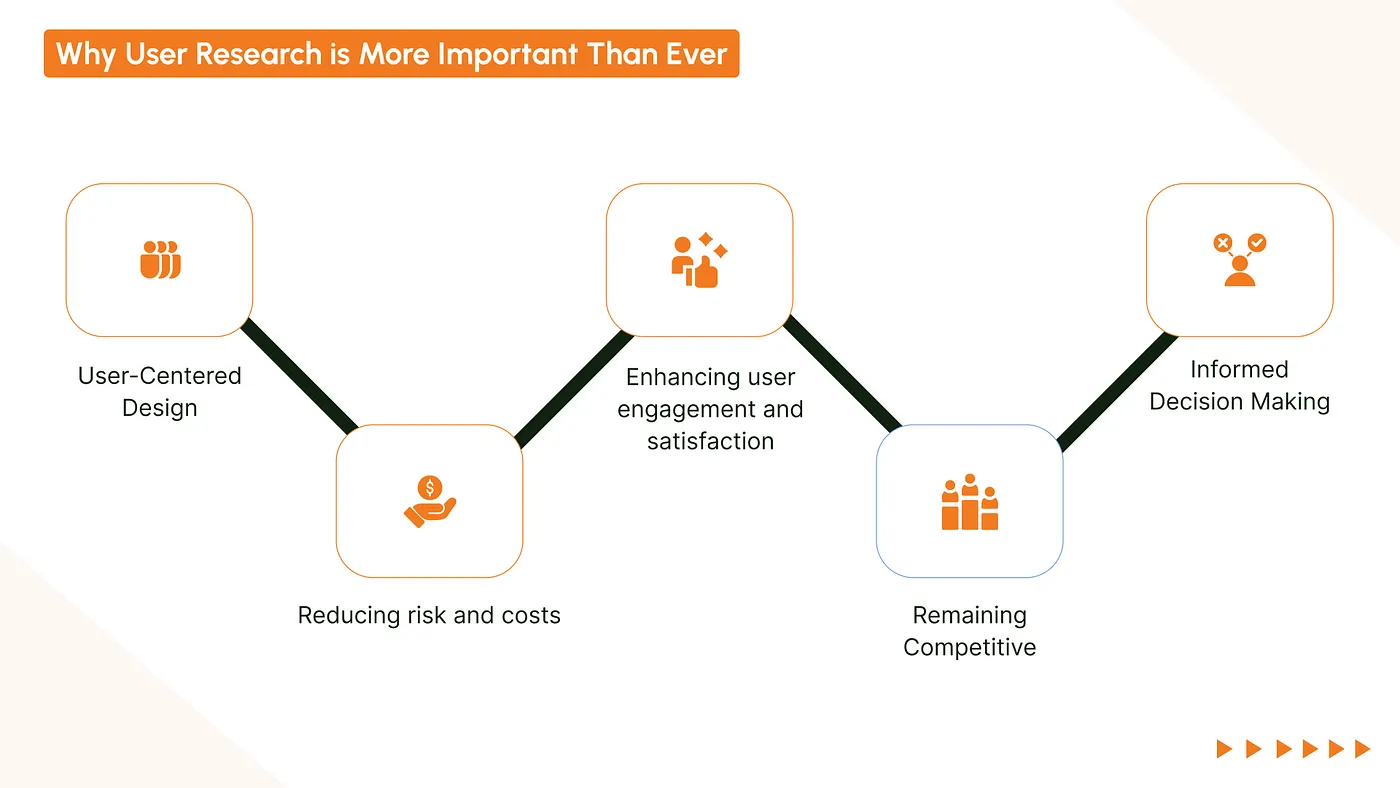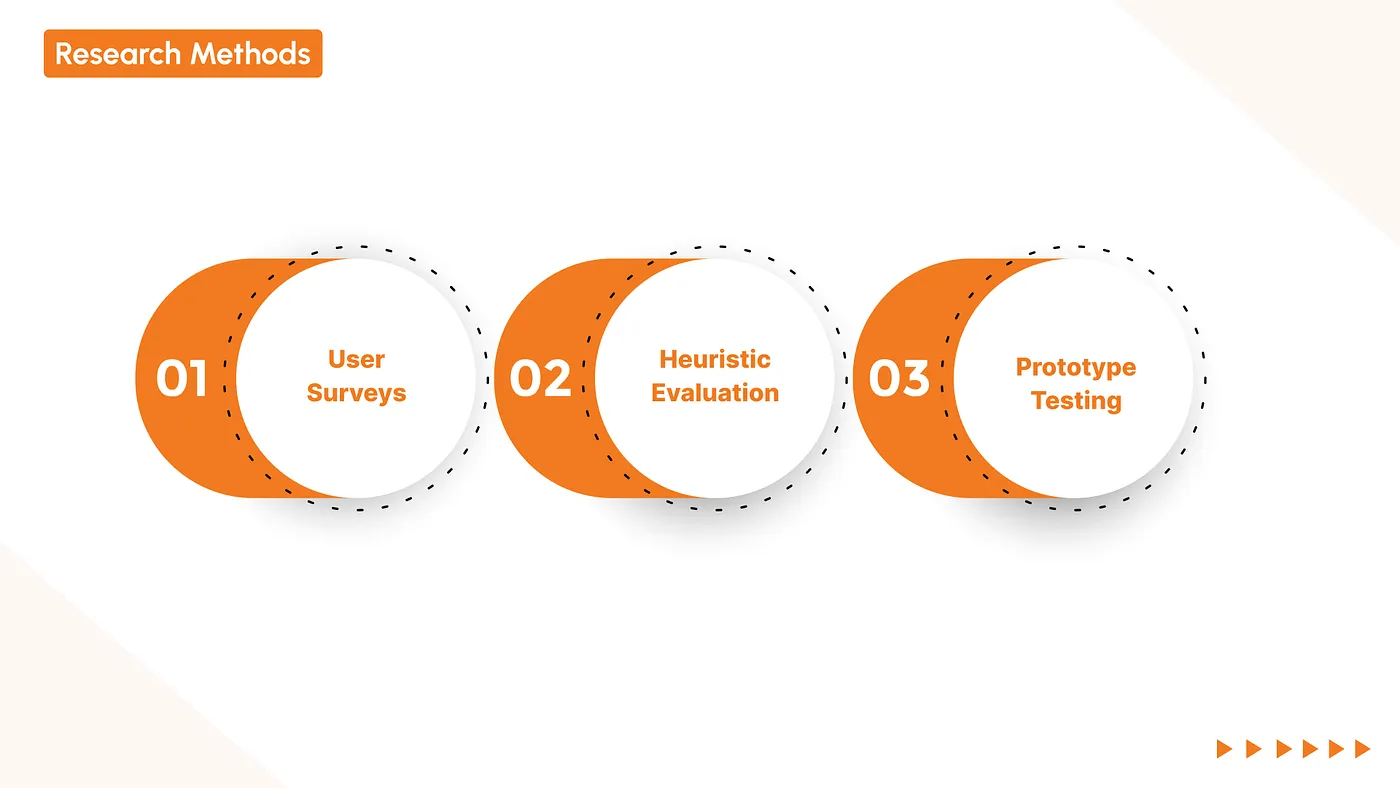The Growing Importance of User Research
In the continuously changing landscape of technology and digital experiences, user research has emerged as an essential component of successful product development. This critical process, which involves studying user behaviors, requirements, and motivations using a variety of methodologies, is no longer a luxury but rather a requirement for firms seeking to build meaningful and effective products.
Understanding User Research
User research uses several strategies to learn about how people engage with products and services. These techniques range from qualitative tactics like interviews and focus groups to quantitative ones like surveys and analytics. The goal is to close the gap between product design and user expectations, ensuring that what is created resonates with its target audience.
Why User Research is More Important Than Ever.

- User-Centered Design.
Today’s customers want personalized and intuitive interactions. User research enables businesses to put consumers at the center of their design processes, ensuring that products are not just useful but also delightful to use. Designers may produce new and user-friendly solutions by knowing the needs and pain points of their users. - Reducing risk and costs.
Investing in user research early in the development process can help to lessen the likelihood of product failure. Companies can save money on redesigns and updates by spotting possible issues and consumer dissatisfaction early on. This proactive strategy not only saves time and resources, but also increases the likelihood that the finished product will succeed in the market. - Enhancing user engagement and satisfaction.
Products developed through user research are more likely to satisfy user expectations, resulting in increased engagement and satisfaction. When users believe a product understands and fulfils their needs, they are more likely to become devoted customers and advocates, which is beneficial to brand reputation and growth. - Remaining Competitive.
In an increasingly competitive economy, keeping ahead needs more than simply creative technologies. Understanding user trends and behaviors can provide a substantial advantage. Companies that priorities user research are better able to foresee market changes and alter their products, accordingly, ensuring their relevance and competitiveness. - Informed Decision Making.
Data-driven decision making is a key component of modern company strategy. User research provides the empirical data required to make sound decisions regarding product features, design aspects, and user experience tactics. This evidence-based strategy ensures that business decisions are based on actual user demands, rather than assumptions or trends.
Methods for User Research.
To effectively capitalize on the benefits of user research, organizations use a variety of methodologies, each providing distinct insights:
- Usability testing:
involves observing users as they engage with a product to uncover usability difficulties and collect input on design features. - Interviews and focus groups:
Working directly with users to obtain a better understanding of their experiences, preferences, and issues. - Surveys and questionnaires:
Gathering quantitative data from many users to find patterns and trends. - Analytics and User Data:
Analyzing user behavior data from digital platforms to better understand how customers interact with a product in real time. - A/B testing:
involves comparing two versions of a product to see which one performs better in terms of consumer engagement and satisfaction.
Case Studies: User Research in Action.
Several prominent companies have proved the effectiveness of user research in developing successful products:
- Apple is well-known for its user-centric approach, which includes extensive user research to ensure that its products are intuitive and match customer expectations. This emphasis on design and usability has contributed to the company’s high brand loyalty and market share.
- Google’s iterative approach to product development is mainly based on user research. Products like Gmail and Google Maps are constantly evolving based on user feedback and behavior data, resulting in highly refined and user-friendly experiences.
- Airbnb: Through considerable research, Airbnb was able to establish a platform that feels personal and trustworthy, revolutionizing the travel and hospitality industries.
Example Case Study
Apple UX Research Case Study: Enhancing User Experience in iOS Applications

Introduction
Apple’s commitment to delivering exceptional user experiences is a cornerstone of its brand identity. This case study explores a UX research project focused on improving the user experience of Apple’s iOS applications. By understanding user behavior and addressing their needs, Apple continues to set benchmarks in usability and design excellence.
Project Overview
The goal of this UX research project was to identify usability issues within Apple’s iOS applications and develop design solutions to enhance user satisfaction. The project employed a variety of research methods, including user surveys, heuristic evaluations, and prototype testing, to gather comprehensive insights.
Research Methods

1.User Surveys:
- Distributed to a broad user base to gather feedback on their experiences with iOS applications.
- Aimed to understand user satisfaction, common challenges, and desired features.
2.Heuristic Evaluation:
- Conducted by UX experts to identify usability issues based on established heuristics.
- Focused on consistency, feedback, and error prevention.
3. Prototype Testing:
- Developed interactive prototypes based on initial findings.
- Tested with real users to observe interactions and gather feedback for further refinement.
Key Findings
1.Navigation and Accessibility:
- Users reported difficulties in navigating complex applications and accessing key features.
- Accessibility issues, particularly for users with disabilities, were identified.
2.Performance and Responsiveness:
- Performance lags and slow responsiveness were common pain points, especially in resource-intensive applications.
- Users emphasized the need for smoother, faster interactions.
3.Visual and Interaction Design:
- Inconsistencies in visual design elements led to confusion and a fragmented user experience.
- Interaction patterns varied significantly across different applications, affecting user familiarity and ease of use.
Solutions and Improvements
1.Streamlined Navigation:
- Redesigned navigation structures to be more intuitive and consistent across applications.
- Implemented accessible design practices to ensure inclusivity for all users.
2.Enhanced Performance:
- Optimized application code and resource management to improve performance and responsiveness.
- Introduced real-time performance monitoring to identify and address issues promptly.
3.Unified Visual Design:
- Established a cohesive design language to ensure visual and interaction consistency.
- Developed comprehensive design guidelines to standardize user experience across all iOS applications.
Conclusion
Apple’s UX research project demonstrates the critical role of user feedback and iterative design in creating exceptional user experiences. By addressing navigation challenges, enhancing performance, and unifying visual design, Apple continues to lead in delivering user-centric digital products. This case study highlights the importance of continuous UX research and innovation in maintaining high user satisfaction and brand loyalty.
Call to Action
For organizations aiming to elevate their digital products, investing in thorough UX research is essential. Understanding user needs and iterating on design based on real feedback can significantly enhance user satisfaction and engagement. Embrace a user-centric approach to design and continuously improve your products to achieve success in the competitive digital landscape.
Ready to elevate your product development process with comprehensive user research? Visit Techforce Global to learn more about our user experience design services and how we can help you create products that truly resonate with your users.
Conclusion
Methods and technologies for user research will grow in tandem with technological advancements. Emerging technologies like artificial intelligence and machine learning are poised to transform the profession, providing deeper insights and more advanced analytical capabilities. However, the essential idea of user research — understanding and empathizing with users — will not alter.
To summarize, the relevance of user research in today’s digital age cannot be emphasized. It is a crucial approach for every organization that wants to build products that resonate with their users, reduce development risks, improve user satisfaction, and remain competitive in the market. Prioritizing user research allows firms to ensure that they are not only meeting, but exceeding, user expectations, paving the way for long-term success and innovation.
 Parth Parmar
31 Jul 2024
Parth Parmar
31 Jul 2024
 US +1 (630) 296 6606
US +1 (630) 296 6606
 India +91 (79) 48904529
India +91 (79) 48904529
 Poland +48 (730) 059 665
Poland +48 (730) 059 665
 reach@techforceglobal.com
reach@techforceglobal.com
 +1 630 303 7389
+1 630 303 7389

 Calendly
Calendly
 LinkedIn
LinkedIn
 Whatsapp
Whatsapp
 Fintech
Fintech
 Education
Education
 Ecommerce
Ecommerce
 Healthcare
Healthcare
 Travel and Hospitality
Travel and Hospitality
 Public Sector
Public Sector




